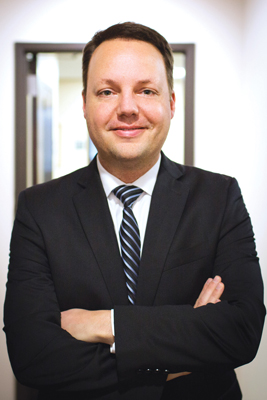Face Time For Melanoma Survivors
Reconstruction after melanoma removal provides both challenges and innovative solutions
As the region’s only fellowship-trained, Double-Board Certified facial plastic and reconstructive surgeon, Timothy J. Minton, MD, often finds himself as part of a tag team.

“I’ll often have combined cases in the OR with our surgical oncologists,” Minton says. “With a melanoma patient, they will perform the resection and I’ll do the reconstruction. We’ll often do our procedures on the same day, which of course is nice for the patient.”
Melanoma requires a wide excision, which means that an area of healthy tissue will be removed along with the melanoma. This can create a challenge in reconstruction, especially when they occur on the face and neck.
“You are removing a pretty wide margin of tissue,” Minton says. The margin is the edge where there is only normal skin remaining and no more cancer. “It can pose some reconstruction challenges. For example, if you’ve got a melanoma near your eyelid, and we’ve got to take a 1 centimeter margin, that may require reconstruction of a highly functional region.”
At Savannah Facial Plastic Surgery, a division of Georgia Ear, Nose & Throat Specialists, Dr. Minton can take a few different paths to reconstruction. He can employ a skin graft, in which a thin layer of healthy skin is removed from another part of the body and transplanted onto the defect. Blood supply will grow into the graft and restore the function and appearance of the area that was removed.
Another solution is called a flap. This procedure also uses healthy tissue from the surrounding skin to repair the defect. It is different from a graft in that it includes an intact blood supply.
“The procedure I choose depends on what will best suit the patient both functionally and cosmetically,” Minton says.
Local flaps use the skin adjacent to the defect, and can be completed in innovative ways. A patient of Dr. Minton’s had a melanoma on her nose. Though it was in an early stage, the removal of the melanoma took a good amount of tissue to clear the margin.
“For this patient, I took skin from the forehead and rotated it down to the nose with the blood vessel,” Minton says. “Over a period of about three weeks, the body’s response is to bring new blood vessel growth into the flap. I can then detach the skin containing the vessel and the patient is left with new tissue at the defect site.”
With follow-up laser procedures and secondary scar-thinning procedures, the fact that there was any reconstruction at all is barely visible.
“The incidence of melanoma is on the rise, and is related to sun exposure,” Minton says. “The head and neck are the most sun-exposed areas on the body. But even though the recommended surgery involves a wide excision, we have options to get good reconstructive results, with minimal scarring and a natural look for the melanoma survivor.”